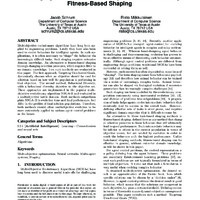Evolving agent behavior in multiobjective domains using fitness-based shaping
Item
-
Title
Evolving agent behavior in multiobjective domains using fitness-based shaping
-
Description
This is an Accepted Manuscript of an article published by ACM. Schrum, J., & Miikkulainen, R. (2010). Evolving Agent Behavior in Multiobjective Domains Using Fitness-based Shaping. In Proceedings of the 12th Annual Conference on Genetic and Evolutionary Computation (pp. 439–446). New York, NY, USA: ACM. https://doi.org/10.1145/1830483.1830567
-
Creator
Schrum, Jacob
Miikkulainen, Risto
-
Identifier
Schrum, J., & Miikkulainen, R. (2010). Evolving Agent Behavior in Multiobjective Domains Using Fitness-based Shaping. In Proceedings of the 12th Annual Conference on Genetic and Evolutionary Computation (pp. 439–446). New York, NY, USA: ACM. https://doi.org/10.1145/1830483.1830567
-
uri
https://collections.southwestern.edu/s/suscholar/item/232
-
Abstract
Multiobjective evolutionary algorithms have long been applied to engineering problems. Lately they have also been used to evolve behaviors for intelligent agents. In such applications, it is often necessary to "shape" the behavior via increasingly difficult tasks. Such shaping requires extensive domain knowledge. An alternative is fitness-based shaping through changing selection pressures, which requires little to no domain knowledge. Two such methods are evaluated in this paper. The first approach, Targeting Unachieved Goals, dynamically chooses when an objective should be used for selection based on how well the population is performing in that objective. The second method, Behavioral Diversity, adds a behavioral diversity objective to the objective set. These approaches are implemented in the popular multiobjective evolutionary algorithm NSGA-II and evaluated in a multiobjective battle domain. Both methods outperform plain NSGA-II in evolution time and final performance, but differ in the profiles of final solution populations. Therefore, both methods should allow multiobjective evolution to be more extensively applied to various agent control problems in the future.
-
Subject
Multiobjective evolution
Algorithms
Evolving agent behavior
Fitness-based shaping
 schrum.gecco10.pdf
schrum.gecco10.pdf